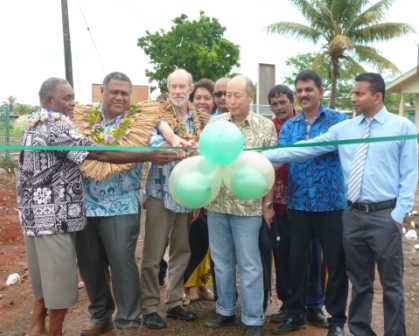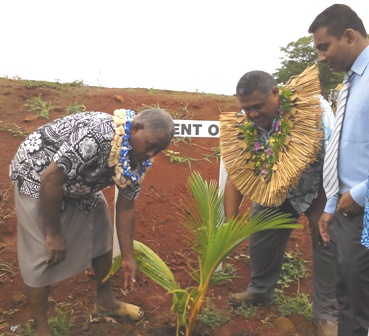
Waste Management and Pollution Control
Labasa, Fiji. The first-ever “climate-proof” landfill in the Pacific designed to better withstand natural hazards and to manage waste produced during disasters, was reopened to the public after rehabilitation on 22 November 2014. Permanent Secretary of Fiji’s Ministry of Local Government, Urban Development, Housing and Environment, Mr Samuela Namosimalua, officially opened the landfill.
Prior to rehabilitation, the old Namara Landfill in Labasa had been prone to flooding during heavy rains resulting in rubbish and leachate spreading out around the dumpsite and polluting the surrounding mangroves and marine environment. The flooding also made the dumpsite inaccessible, causing an additional problem of truckloads of rubbish left sitting in the dump trucks until improved weather permitted access.

The partners at the official openng of the rehabilitated landfill
The site now houses an office building from which workers can transact business and ensure quality control of incoming wastes and collection of necessary data. The newly built hazardous and E-waste storage areas will also ensure separation of health risk wastes from general wastes.
Dr. David Haynes, Director of SPREP’s Waste Management and Pollution Control Division handed over the operation of the rehabilitated landfill to the Labasa Town Council's CEO, Mr Jitendra Prasad, and assured the Labasa community that the rehabilitated landfill would mean healthier mangrove ecosystems and a safer environment for the surrounding urban neighborhood.
"The transformation of this landfill from when I visited it in April 2014 is remarkable, with accessible roads, a proper drainage system, a pond to capture and reduce leachate spillage to the sensitive environment around the site, less fire risks with regulated gas flow from the landfill vents, and of course, controlled dumping of waste now being enforced," he noted.
Permanent Secretary Namosimalua reiterated the adverse impacts weather and climate events bring to the country, including damage to infrastructure such as waste disposal facilities. "These events will increase the risk of environmental contamination, inundation of coastal waste disposal sites causing pollution from noxious substances, and scattering of wastes on poorly operated inland dumpsites affecting our limited vulnerable resources like water and pose a great threat to public health," he commented.
The rehabilitated landfill has been developed to better withstand such risks and further incorporates provisions for best practices in disaster waste management. Significant volumes of wastes are generated during disaster events, much of which can be recycled, and the inclusion of a dedicated cell to receive these “disaster wastes” will help reduce pressure on the landfill space.
The rehabilitation of the Namara Landfill has been made possible through the Integrated Climate Change Adaptation Initiative (ICCAI) Program of the Australian Government’s Department of Foreign Affairs and Trade (DFAT). The project was implemented by the Secretariat of the Pacific Regional Environment Programme (SPREP) with the technical expertise of the Japanese Technical Cooperation Project for Promotion of Regional Initiative on Solid Waste Management in Pacific Island Countries (J-PRISM).
Labasa Town Council CEO, Mr Jitendra Prasad, expressed the Council’s appreciation for the assistance given by the Australian Government, SPREP and JICA and, to commemorate the partnerships, tree seedlings were planted by each Agency on the site. The trees will provide a lasting reminder on the site of the partnership which helped achieve this innovative project.
Prior to rehabilitation, the old Namara Landfill in Labasa had been prone to flooding during heavy rains resulting in rubbish and leachate spreading out around the dumpsite and polluting the surrounding mangroves and marine environment. The flooding also made the dumpsite inaccessible, causing an additional problem of truckloads of rubbish left sitting in the dump trucks until improved weather permitted access.

The partners at the official openng of the rehabilitated landfill
The site now houses an office building from which workers can transact business and ensure quality control of incoming wastes and collection of necessary data. The newly built hazardous and E-waste storage areas will also ensure separation of health risk wastes from general wastes.
Dr. David Haynes, Director of SPREP’s Waste Management and Pollution Control Division handed over the operation of the rehabilitated landfill to the Labasa Town Council's CEO, Mr Jitendra Prasad, and assured the Labasa community that the rehabilitated landfill would mean healthier mangrove ecosystems and a safer environment for the surrounding urban neighborhood.
"The transformation of this landfill from when I visited it in April 2014 is remarkable, with accessible roads, a proper drainage system, a pond to capture and reduce leachate spillage to the sensitive environment around the site, less fire risks with regulated gas flow from the landfill vents, and of course, controlled dumping of waste now being enforced," he noted.
Permanent Secretary Namosimalua reiterated the adverse impacts weather and climate events bring to the country, including damage to infrastructure such as waste disposal facilities. "These events will increase the risk of environmental contamination, inundation of coastal waste disposal sites causing pollution from noxious substances, and scattering of wastes on poorly operated inland dumpsites affecting our limited vulnerable resources like water and pose a great threat to public health," he commented.
The rehabilitated landfill has been developed to better withstand such risks and further incorporates provisions for best practices in disaster waste management. Significant volumes of wastes are generated during disaster events, much of which can be recycled, and the inclusion of a dedicated cell to receive these “disaster wastes” will help reduce pressure on the landfill space.
The rehabilitation of the Namara Landfill has been made possible through the Integrated Climate Change Adaptation Initiative (ICCAI) Program of the Australian Government’s Department of Foreign Affairs and Trade (DFAT). The project was implemented by the Secretariat of the Pacific Regional Environment Programme (SPREP) with the technical expertise of the Japanese Technical Cooperation Project for Promotion of Regional Initiative on Solid Waste Management in Pacific Island Countries (J-PRISM).
Labasa Town Council CEO, Mr Jitendra Prasad, expressed the Council’s appreciation for the assistance given by the Australian Government, SPREP and JICA and, to commemorate the partnerships, tree seedlings were planted by each Agency on the site. The trees will provide a lasting reminder on the site of the partnership which helped achieve this innovative project.

Mr Samuela Namosimalua plants a tree on the site